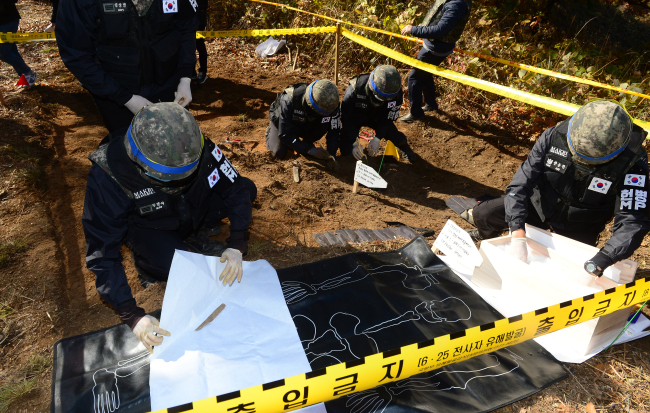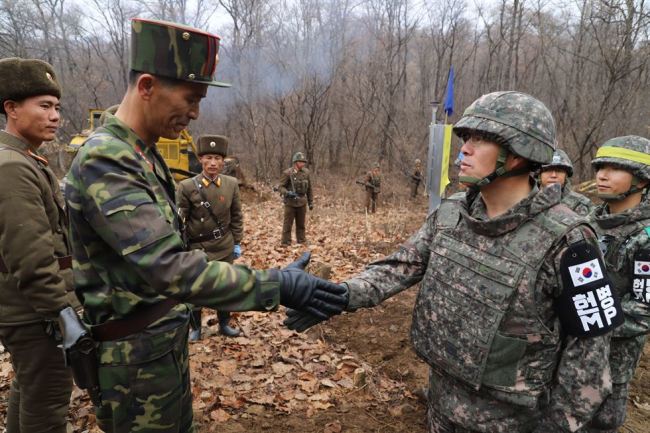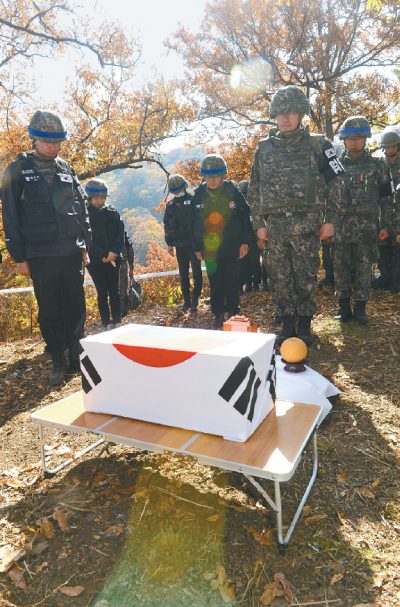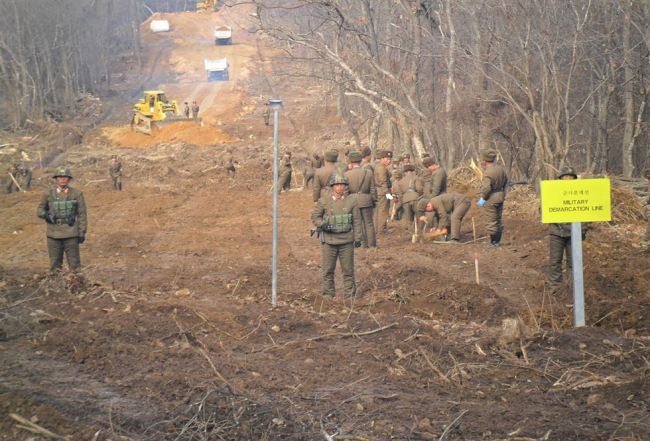[Feature] North Korea drags its feet on joint work to return Korean War dead
With Pyongyang not fulfilling agreement on excavation of remains at Arrowhead Ridge, Seoul starts digging on its own
By Jo He-rimPublished : April 1, 2019 - 15:06
When Park Woo-bokrye, 71, learned that the remains of her eldest brother had been found on the infamous Arrowhead Ridge, decades after he died fighting in the Korean War, she felt both excitement and regret.
“My mother missed him so much. It would have been very nice if his remains could have returned before mother passed away,” Park, 71, said during the burial ceremony held at Daejeon National Cemetery on March 26, when her brother, Sgt. Park Jae-gwon, was laid to rest.
“I am still deeply affected that we found him. I would like to thank the country and the military.”
Hundreds of young soldiers remain buried at Arrowhead Ridge in the heavily fortified Demilitarized Zone between the two Koreas, the scene of one of fiercest battles in the 1950-53 Korean War.
While the excavation of the remains of fallen soldiers near the border in Gangwon Province had been a long-held hope, it was only last year that the two Koreas formally agreed to conduct a joint recovery project in the area. Hopes were raised among the bereaved families that their beloved ones would finally be laid to rest.
“My mother missed him so much. It would have been very nice if his remains could have returned before mother passed away,” Park, 71, said during the burial ceremony held at Daejeon National Cemetery on March 26, when her brother, Sgt. Park Jae-gwon, was laid to rest.
“I am still deeply affected that we found him. I would like to thank the country and the military.”
Hundreds of young soldiers remain buried at Arrowhead Ridge in the heavily fortified Demilitarized Zone between the two Koreas, the scene of one of fiercest battles in the 1950-53 Korean War.
While the excavation of the remains of fallen soldiers near the border in Gangwon Province had been a long-held hope, it was only last year that the two Koreas formally agreed to conduct a joint recovery project in the area. Hopes were raised among the bereaved families that their beloved ones would finally be laid to rest.


In the Comprehensive Military Agreement signed on Sept. 19 last year in Pyongyang, following a summit meeting between President Moon Jae-in and North Korean leader Kim Jong-un, the two Koreas specified the joint recovery project period as being from April 1 to Oct. 31 this year. The two sides then removed some land mines in the area and built roads inside the DMZ to facilitate the project.
Since the end of last year, however, North Korea has been mum about further steps, leaving the South to start what was meant to be a joint excavation project on its own.
On Monday, the South Korean military was to start removing more land mines in the area.
“From Monday, we will start additional demining operations and basic excavation work on the south side of the Military Demarcation Line (on the ridge),” the Defense Ministry said Sunday. “It is preparatory work, but it is basically starting the joint recovery project.”
War takes its toll
The remains of the late Sgt. Park were retrieved in October, when the South Korean military conducted a demining operation in preparation for the joint excavation of war remains. He was the first to be identified among 13 who were found during the mine removal.
Park joined the Army’s second infantry division in 1952 at the age of 22. He fought on the front line in Gangwon Province against the North Korean and Chinese communist forces -- who were just as young as he. Then, barely a month before the conflict ended, Park died in the highlands of Cheorwon, fighting two decisive battles there.

When his cousin Jung-yeon saw the news on TV about his uncle in February, he could only think that it must have been someone with the same name.
“It has been over six decades. When I received calls from the government, at first I thought it was voice phishing,” Park Jung-yeon, 57, told The Korea Herald.
While the war was before he was born, Jung-yeon was well aware of the toll of the war as well as its aftermath -- he lost his father and three other relatives.
“My older aunt had told me that they received uncle’s nail clippings and hair in a box, which came with a notice that he had died in the war,” Jung-yeon said. “The government at the time must have collected the samples before sending the soldiers onto the battlefield, as it would be hard to retrieve the body.”
His grandparents and aunts buried the nail clippings and hair. They did not know where he was killed, and it came as a surprise when the remains of his uncle were found on Arrowhead Ridge.
According to Jung-yeon, Jae-gwon’s two other cousins were also injured and died in the war. One of them was laid to rest at Daejeon National Cemetery.
Jung-yeon’s father also passed away at 39 from wounds from stepping on a land mine while serving in the military in Inje, Gangwon Province. While he did not die fighting in the war, the land mine was a relic of that war.
Jung-yeon wished for North Korea to cooperate for a speedy joint recovery.
“There have been opinions that we should start the project on our own if the North does not take part. It has been too long, and while there still are bereaved families that live to see their loved ones laid to rest, many of them have passed away, like my aunts,” Jung-yeon said.
Bringing youth back to rest in peace
About 200 South Korean soldiers and some 100 UN Command Forces, such as of US and French battalions, may be buried on Arrowhead Ridge, according to the Ministry of National Defense. A great number of North Korean and Chinese soldiers are also thought to be buried there, the ministry said.
At 281 meters high, Arrowhead Ridge was a strategic point for the warring sides, along with Baengma Ridge and Heartbreak Ridge just a few kilometers away.
According to the Defense Ministry, historical factors, accessibility for both South and North Korea and the estimated number of remains buried were taken into consideration in choosing Arrowhead Ridge for the joint recovery project. The successful completion of the project could lead to recovery missions in other parts of the Demilitarized Zone, where some 10,000 additional remains of soldiers are thought to be buried.

With the North’s silence, the joint recovery project has become the first breach of the military pact signed last year, as it was the only one with specific dates for commencing and concluding a project.
On March 6, the Defense Ministry sent a list of its excavation team to the North, but Pyongyang has continued to remain silent. When Seoul offered to hold general-level talks on March 18 via the military communication line, officials there said they would report the request to “superior authority.”
South Korea is still waiting for the North’s response to conduct the recovery project together.
“We are preparing in advance so that when the North does respond, we can start the excavation project together right away,” a Defense Ministry official said.
According to the recovery and identification agency, about 11,550 remains of soldiers killed during the Korean War have been retrieved, while 124,000 are still considered missing. Just 132 have been identified.
(herim@heraldcorp.com)







![[Graphic News] More Koreans say they plan long-distance trips this year](http://res.heraldm.com/phpwas/restmb_idxmake.php?idx=644&simg=/content/image/2024/04/17/20240417050828_0.gif&u=)
![[KH Explains] Hyundai's full hybrid edge to pay off amid slow transition to pure EVs](http://res.heraldm.com/phpwas/restmb_idxmake.php?idx=644&simg=/content/image/2024/04/18/20240418050645_0.jpg&u=20240419100350)






![[From the Scene] Monks, Buddhists hail return of remains of Buddhas](http://res.heraldm.com/phpwas/restmb_idxmake.php?idx=652&simg=/content/image/2024/04/19/20240419050617_0.jpg&u=20240419175937)

![[KH Explains] Hyundai's full hybrid edge to pay off amid slow transition to pure EVs](http://res.heraldm.com/phpwas/restmb_idxmake.php?idx=652&simg=/content/image/2024/04/18/20240418050645_0.jpg&u=20240419100350)

![[Today’s K-pop] Illit drops debut single remix](http://res.heraldm.com/phpwas/restmb_idxmake.php?idx=642&simg=/content/image/2024/04/19/20240419050612_0.jpg&u=)